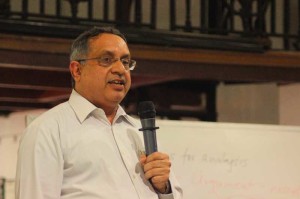Professor Sethi in his workshop presented a template of recording and teaching history and suddenly, everyone found themselves back in a classroom.
The very first element of the model requires the historian or the teacher in the classroom to raise problems for analysis –- at what time does Sikhism begin to be recognised as a faith or when is it that it enters into a debate with Hinduism? Even though Pakistan is now a state in itself, Kashmir has been unable to establish itself as a state. Now why is that? Even more disconcerting questions have to be raised such as whether nationalism would have happened in India without British rule or if nationalism itself is a dubious construct. Or even why even though the Kothari Commission recommended it in the 1940’s, there is no common school system in India while one exists in U.S.A.
The second element would be to address these questions and offer varying explanations in the form of a narrative or argument. This explanation must rest on the facts of the case which should rise from evidence based on an identifiable body of sources, stressing the interconnection of things. There are questions to be addressed in this element too, such as why we favour argument over narrative or if description can be bereft of analysis. The art, declared Professor Sethi, is in how one of these can be folded into the other. Take for instance Cynthia Oziek, the literary critic who enmeshes stories within her essays and essays within her stories. Lawrence stone, mentions Professor Sethi, argued that history is the narrative which can incorporate arguments about structure and function. Within specific conjunctures, change can only be explained with detail which is provided by narrative.
The third element is that of perspective or ideology within which histories are shaped. Multivocality provides the different perspectives which history often veers away from, speaking of human conditions instead of pointing out the heteroglossia. It is possible, he says, to synthesise perspectives but it is sometimes deliberately not done. He repeated his earlier observation of the difference between perspective and prejudice and the easy elimination of the latter from history. The ideal historian is one who recognises his or her own prejudices and exempts them from the matter presented. The historian has to recognise their location in the schematics of power, looking as Marx suggested, at structure, circumstance as well as individual agency. He mentioned here the example of Bernard Louis’s History Remembered, Recovered, Invented. The multiple perspectives also help to see whether the arguments presented by the historian are reductionist.
The fourth element is the categorisation employed in the narrative – language being elastic, one has to be technically sound to ensure that the reader of the text understands exactly that which is intended by the author. He related an incident wherein the NCERT got into trouble over the sentence ‘In the 18th century the Jats plundered Delhi’. He still is unsure which word incited the community enough to ensure that the text was altered – was it the categorisation of the Jats as a whole? Or was it perhaps the word ‘plundered’? Would it have been better to qualify the category Jats? We shall never know. But the incident brings out the sheer importance of careful categorisation.
When the floor was opened to questions, the first that came up was how one is to distinguish between the historian who follows evidence and the one that doesn’t. Professor Sethi’s solution was to identify whether the text is guilty of suppressing evidence or emphasising certain facts to tilt the perspective. The Nazi historian, for example, would have to stand with how his perspective interacts with other perspectives. Asked how we should deal with the silences of the British Empire about colonial history, he advised the audience to fill the gap carefully, with evidence, distinguishing between perspective and propaganda. History, he said, is an ideographic discipline where generalisations are very difficult to achieve. There needs to be a balance in the ratio of syncreticism and reconciliation of opinions and practices. Here, Ms Shazada commented that Cambridge University offers different histories for students from different countries. In Pakistan, for example, a student has to take up Islam studies and Pakistan studies to get through to college. Professor Sethi was then asked how a teacher in the classroom is to deal with the modifying effect time and space has on perspectives. He said that it is because the questions have changed, our location in time is different and the moral universe has changed that our perspectives have changed as well. The best way to deal with the changing perspective is by employing experiences. When asked to explain his definition of generalisation, he said that generalistion is that which follows an underlined structure so that it works for all sets of data one has gone through. Time and space are the variables to be considered in this respect. The NCERT testimonies concerning the partition, he attested when asked, had been obtained by him during his research on partition stories and the rest from an archive of oral narrative that he had helped create in Japan.
As the first day of the conference ended, we realised that it had been an exciting, stimulating and informative, albeit long day.
–Anushka Halder

